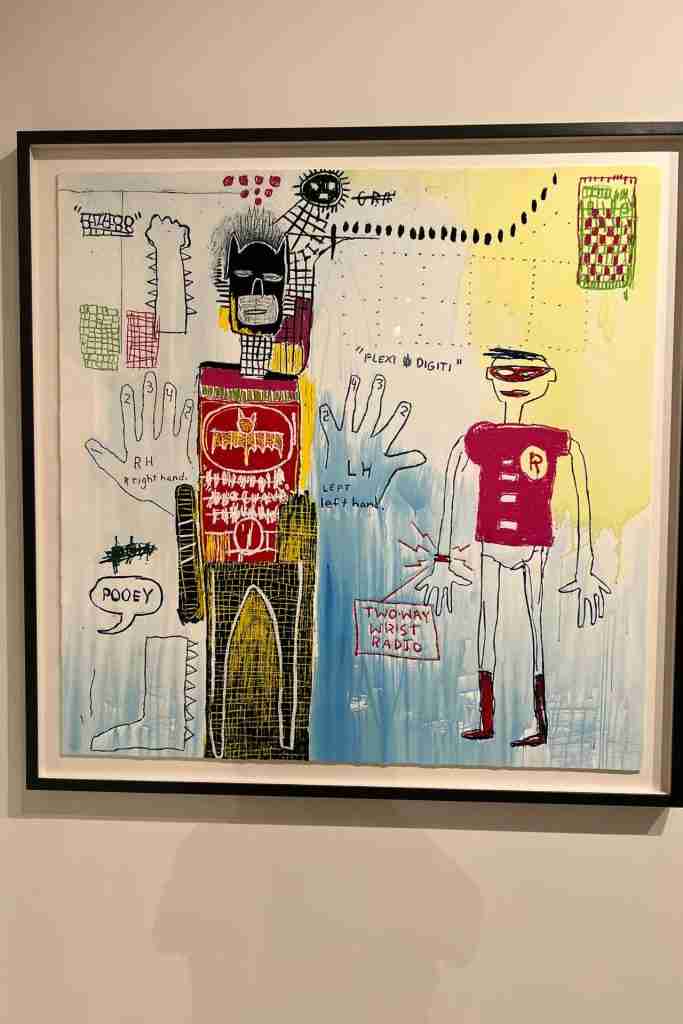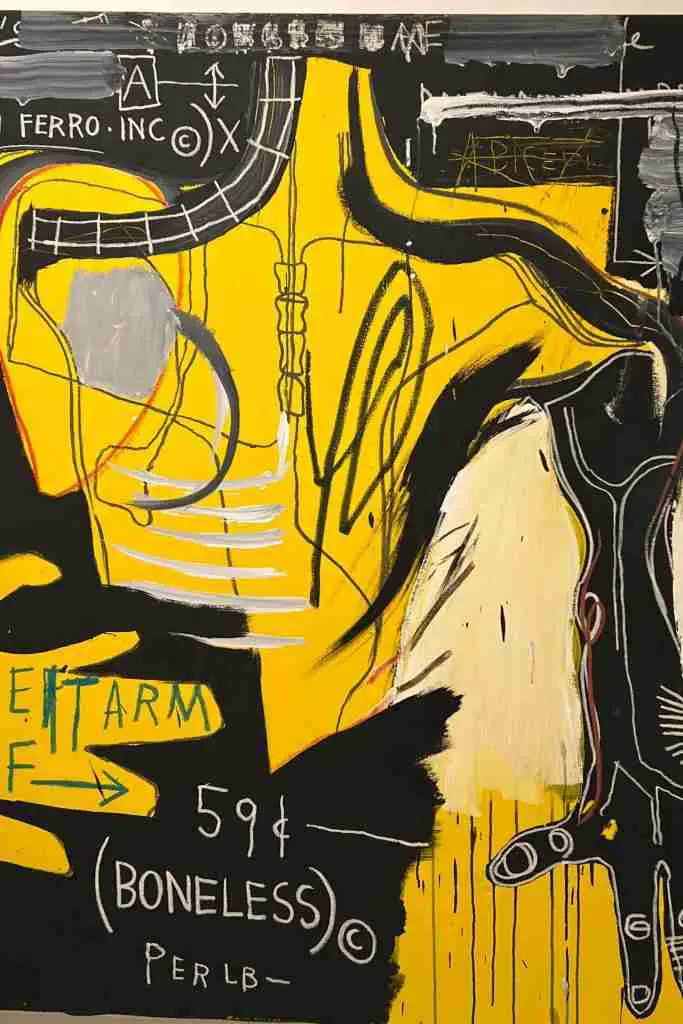In the dissonant streets of New York’s Lower East Side, a young Jean-Michel Basquiat transformed the city’s subway walls into canvases of social outcry and abstract narrative. Born to a Haitian father and Puerto Rican mother in 1960, his early years were punctuated with diversity and struggle, a precursor to the themes that would define his art. The pulse of the city—a medley of languages, cultures, and social discord—coursed through him, materializing in the cryptic text and fragmented figures that populated his work.
As artist Julian Schnabel rightly noted, “He ate up every image, whether it was a Batman comic, a political cartoon, or a photo of a great work of art.”
In this content we’ll discuss Jean-Michel Basquiat: a tapestry of rebellion and genius stitched in street vernacular.

Basquiat rebel and genius: unearthing beauty in chaos
Basquiat’s art was a dialogue between conflict and beauty, a raw representation of the human condition. His pieces were spontaneous, fluid, and irrepressible. They made you pause and think, if not for their aesthetic allure, then for their thematic gravity. Scrawled words intersected with vibrant hues and chaotic lines. It was as though Basquiat, in his artistic frenzy, was desperately trying to make sense of the world around him—its disparity, its injustice, and its fleeting moments of splendor.
Warhol said of Basquiat, “He had a great instinct for what mattered.”
Basquiat rebel and genius: the crown motif – a signature of royalty and rebellion
One of the most recurring symbols in Basquiat’s art is the three-pointed crown. While the crown is typically a symbol of royalty, Basquiat’s crowns sat atop the heads of jazz musicians, warriors, and outcasts rather than traditional kings and queens. In doing so, Basquiat was effectively democratizing the notion of grandeur, alluding to the regality that exists in marginalized communities. This simple, yet potent, motif represents a shift in narrative power, a challenge to conventional Western depictions of worthiness and esteem.

A confluence of culture: intersecting Afro-Caribbean and American narratives
The multi-cultural tapestry of Basquiat’s background manifested in his work as a confluence of Afro-Caribbean folklore, American pop culture, and historical references. Figures from Haitian Vodou cohabited the canvas with American boxers and jazz musicians, often disfigured or morphed into hybrid identities.
This integration of diverse symbols and characters challenged the prevailing, one-dimensional stereotypes about race and culture, revealing the complex interior lives of individuals often viewed through a simplistic lens.
Basquiat rebel and genius: the dichotomy of fame – a meteoric rise and the weight of celebrity
Basquiat’s ascent to art stardom was as meteoric as it was fraught with the perils of fame. Once a street artist barely making ends meet, found himself in the opulent halls of galleries and the social circles of art-world luminaries like Andy Warhol. The sudden attention thrust upon him was a double-edged sword. On one hand, it allowed him a platform to amplify the messages embedded within his art; on the other, it cultivated a persona that risked overshadowing the profundity of his work.
As Basquiat himself remarked, “I wanted to be a star, not a gallery mascot.”
Basquiat rebel and genius: the resonance of artist’s legacy
Basquiat died at the tragically young age of 27, but his influence reverberates through contemporary art and culture to this day. The ephemerality of life, a theme inherent in his work, ironically captures the timelessness of his influence. His art is a masterclass in the complexity of simplicity, a visual dialogue that beckons even as it defies. It’s an invitation to explore and challenge our own perceptions about race, class, and the intricacies of human emotion.
The Basquiat-Warhol nexus: an alliance of contrasts and symbiosis
Arguably one of the most fascinating chapters in Basquiat’s life is his friendship and collaborative partnership with the titan of Pop Art, Andy Warhol. At first glance, the alliance seemed improbable: Warhol, the white, older, established iconoclast, and Basquiat, the young, Black upstart bursting onto the art scene with a restless energy. Yet, their relationship was marked by mutual admiration and a shared sense of outsider status.
Warhol was captivated by Basquiat’s raw talent and audacity, while found in Warhol a mentor who had navigated the labyrinthine corridors of art-world fame and survived its pitfalls. Together, they created works that defied neat categorization, blurring the lines between commercial art and highbrow cultural critique. Warhol’s influence on Basquiat was evident in the latter’s growing tendency towards serial motifs, while injected a fervor and spontaneity into Warhol’s more calculated approach.
As Warhol biographer Victor Bockris observed, “Jean was the catalyst who had helped get Andy painting again.” But the relationship wasn’t without its tensions, sometimes exacerbated by the spotlight that continually hovered over both artists. Despite the complexities, their friendship provided both with something intangible yet essential—a sanctuary of creativity and understanding in a world often more interested in their personas than their art.
Incorporating this multifaceted relationship into the tapestry of Basquiat’s life adds yet another layer of complexity to an artist who thrived on the intricate, the contradictory, and the profoundly human. It serves as a reminder that art is not created in a vacuum but within a web of relationships that nourish, challenge, and ultimately shape the creative spirit.
The unending conversation: Basquiat in contemporary discourse
Three decades since his passing, the narrative around him continues to evolve. Museum exhibitions, scholarly works, and even fashion lines inspired by his art contribute to a renewed understanding and appreciation of his genius. Yet, the enigma remains, preserved in the layers of paint and the labyrinthine strokes of his creations.
As we engage with his work, we are not merely spectators, but participants in a dialogue that him initiated but never sought to conclude. In his own words, “I don’t think about art while I work. I think about life.”

The Bottom Line
In this content we talked about Jean-Michel Basquiat: a tapestry of rebellion and genius stitched in street vernacular. When contemplating the life and art of Jean-Michel Basquiat, you realize that they are inseparable, stitched together in a tapestry that continues to unravel and redefine itself in the collective consciousness. This tapestry, woven with threads of rebellion, genius, and the street vernacular that was his lexicon, is his enduring legacy—a piece of immortality left behind in a world still grappling with the themes he explored so passionately. Keep follow our blog to discover more about art, history, travel, lifestyle and our new LCN App.

